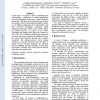Free Online Productivity Tools
i2Speak
i2Symbol
i2OCR
iTex2Img
iWeb2Print
iWeb2Shot
i2Type
iPdf2Split
iPdf2Merge
i2Bopomofo
i2Arabic
i2Style
i2Image
i2PDF
iLatex2Rtf
Sci2ools
AHS
2007
IEEE
2007
IEEE
Synthesis of Multimode digital signal processing systems
In this paper, we propose a design methodology for implementing a multimode (or multi-configuration) and multi-throughput system into a single hardware architecture. The inputs of the design flow are the data flow graphs (DFGs), representing the different modes (i.e. the different applications to be implemented), with their respective throughput constraints. While traditional approaches merge DFGs together before the synthesis process, we propose to use ad-hoc scheduling and binding steps during the synthesis of each DFG. The scheduling, which assigns operations to specific time steps, maximizes the similarity between the control steps and thus decreases the controller complexity. The binding process, which assigns operations to specific functional units and data to specific storage elements, maximizes the similarity between datapaths and thus minimizes steering logic and register overhead. First results show the interest of the proposed synthesis flow.
| Added | 12 Aug 2010 |
| Updated | 12 Aug 2010 |
| Type | Conference |
| Year | 2007 |
| Where | AHS |
| Authors | Caaliph Andriamisaina, Emmanuel Casseau, Philippe Coussy |
Comments (0)

